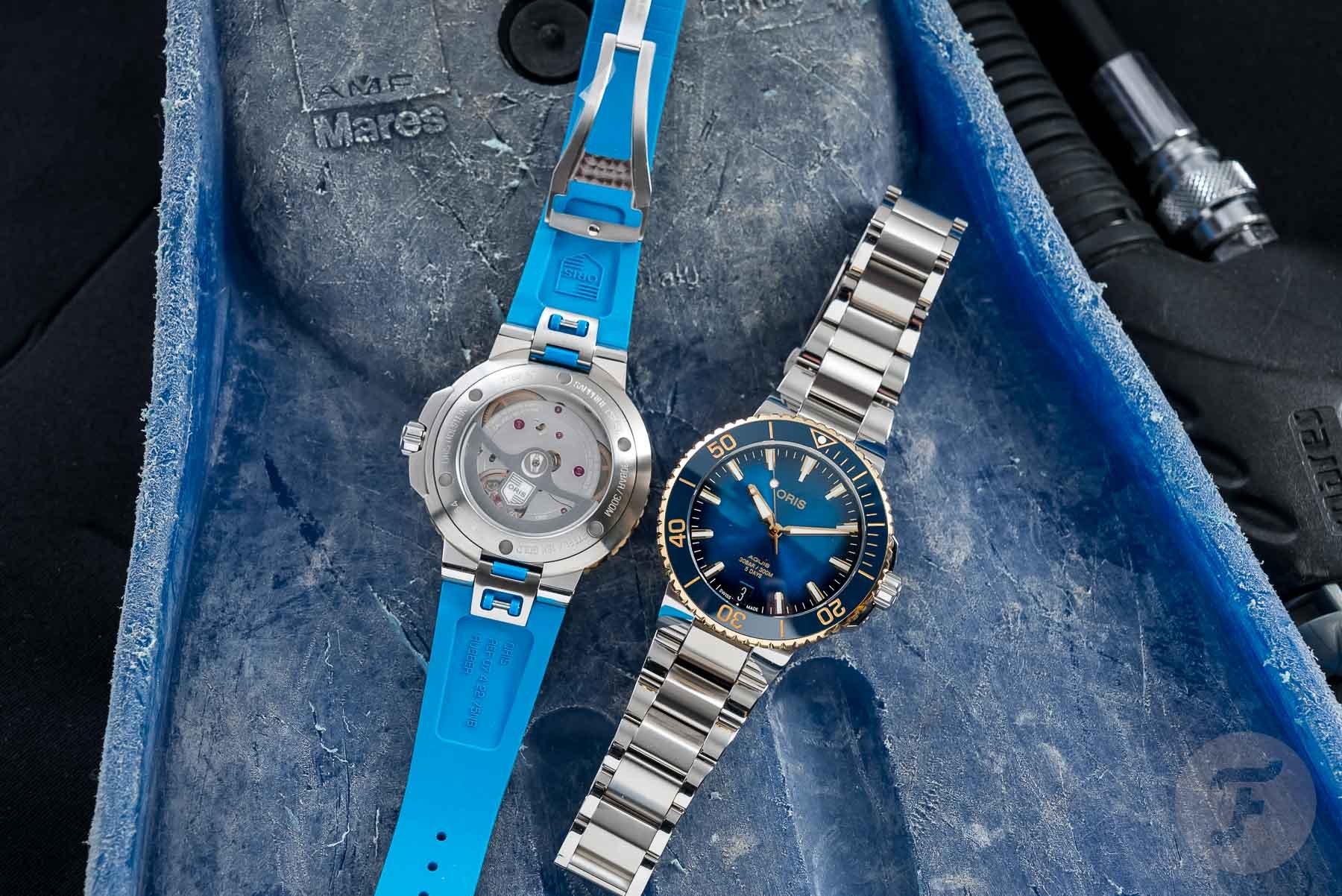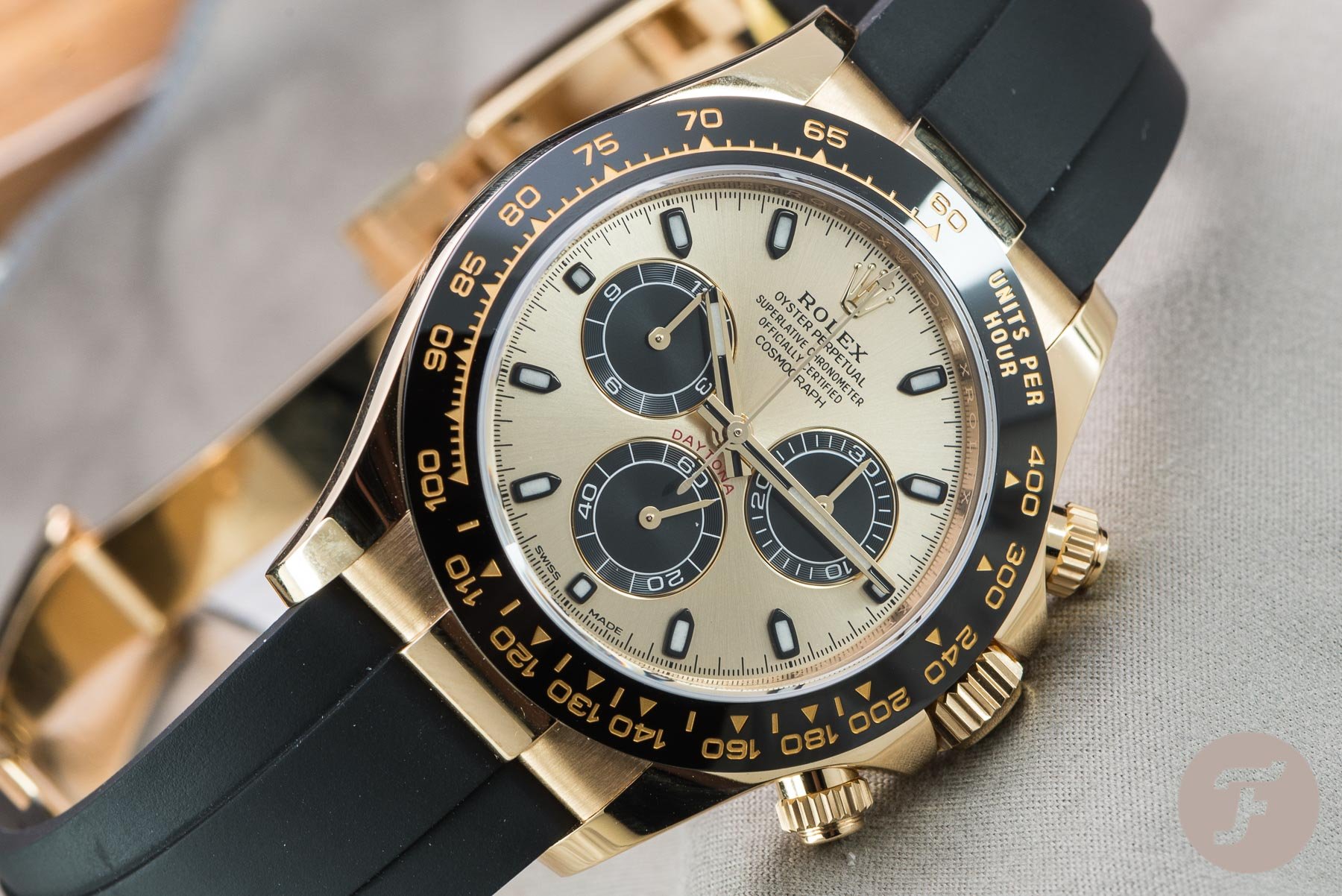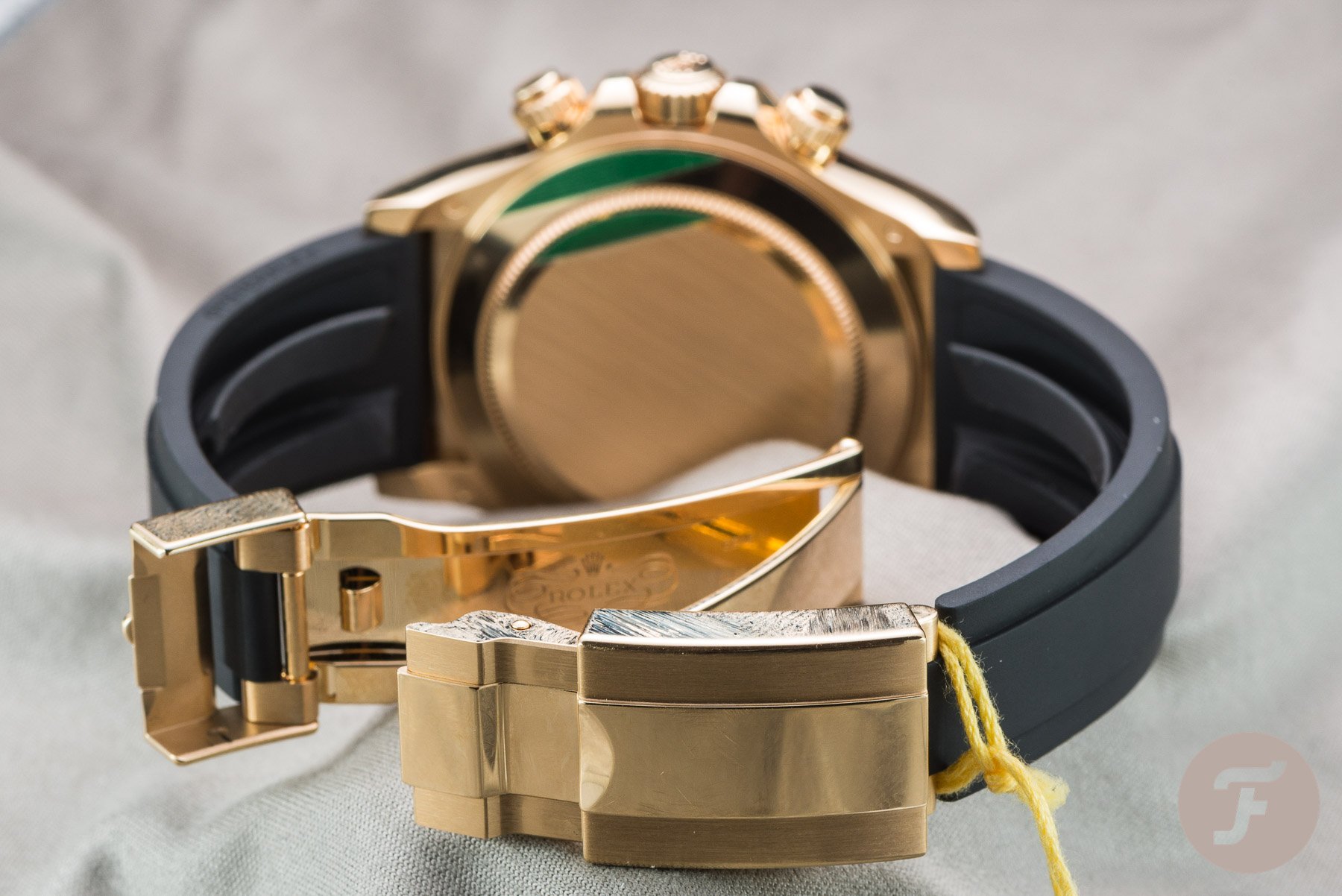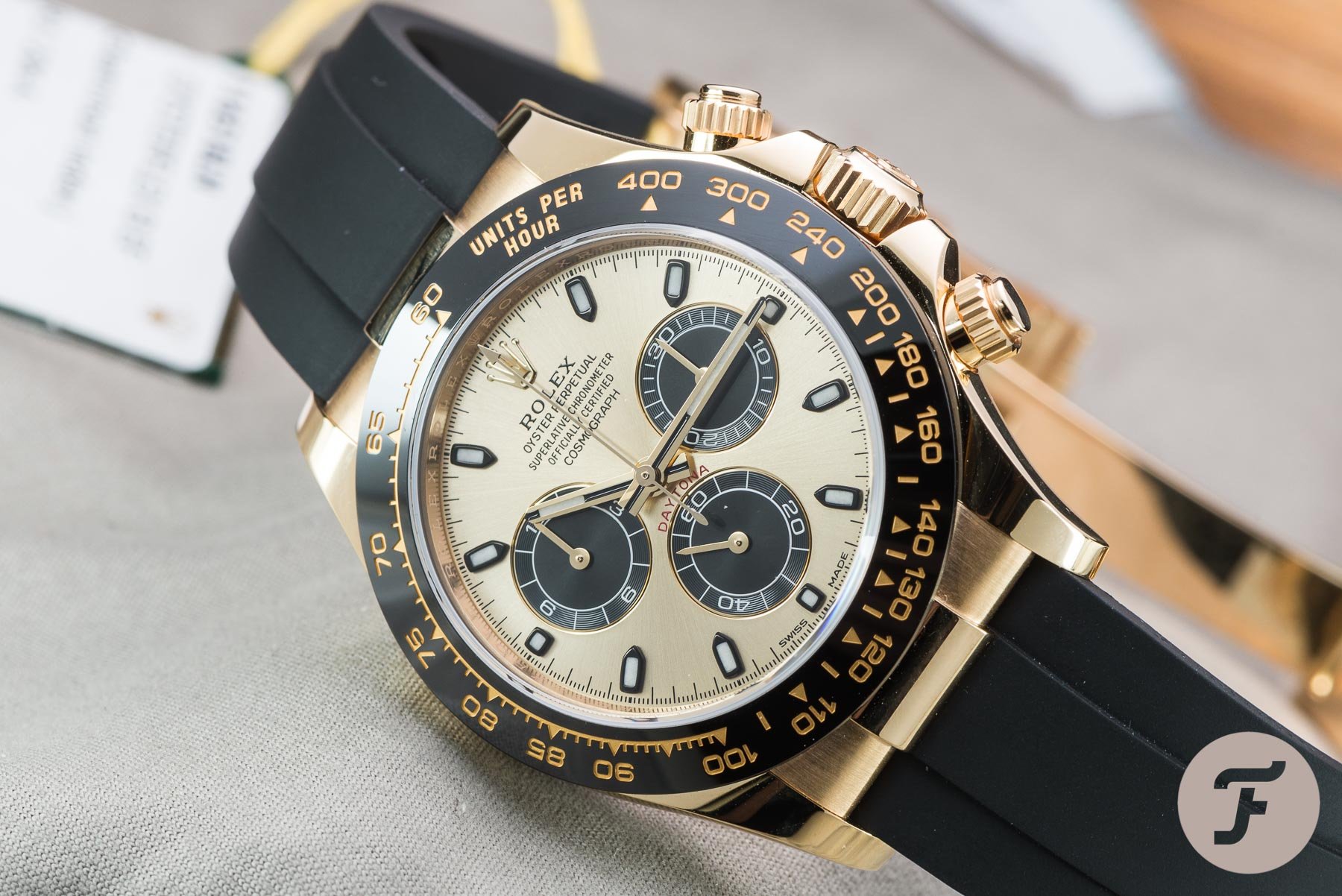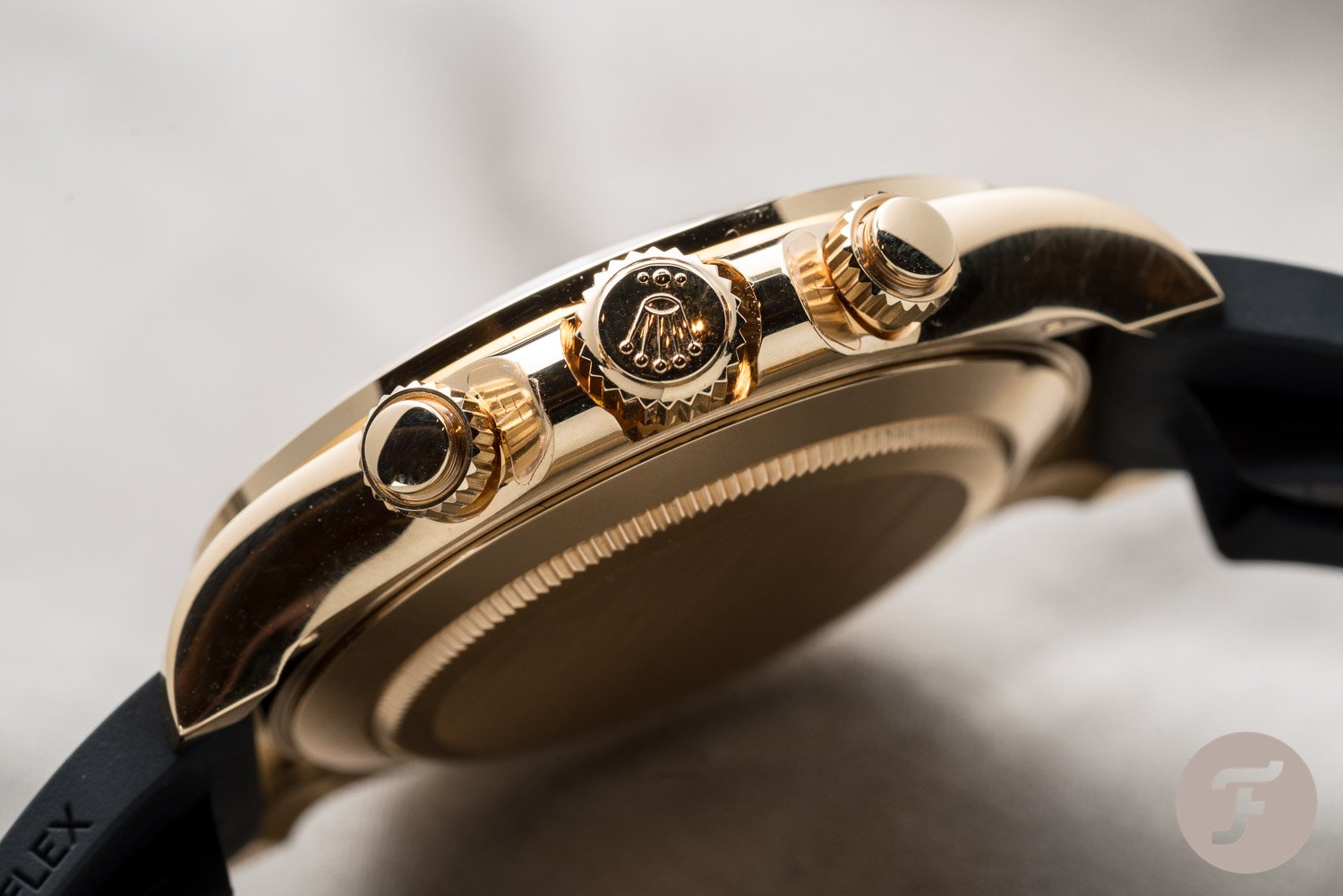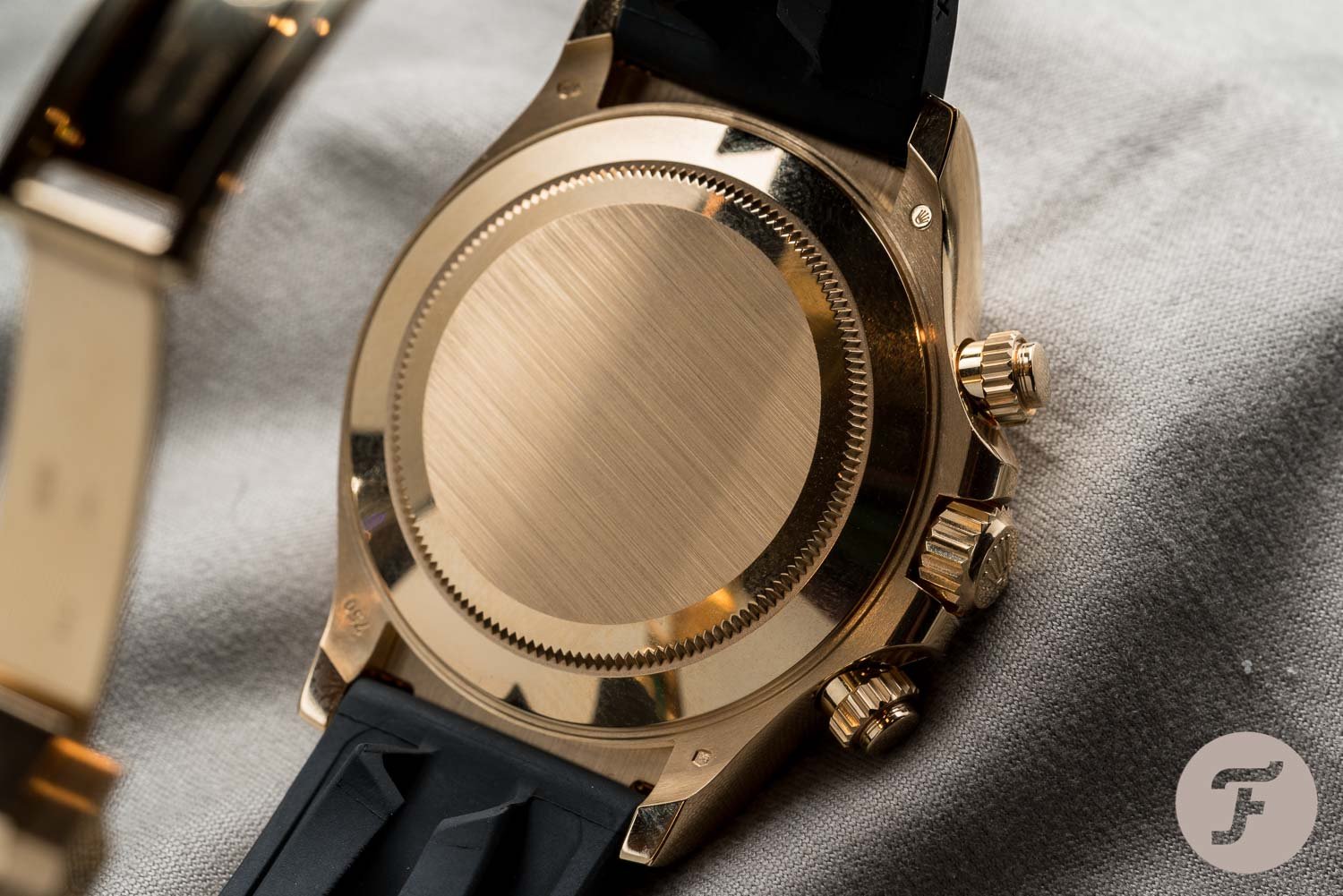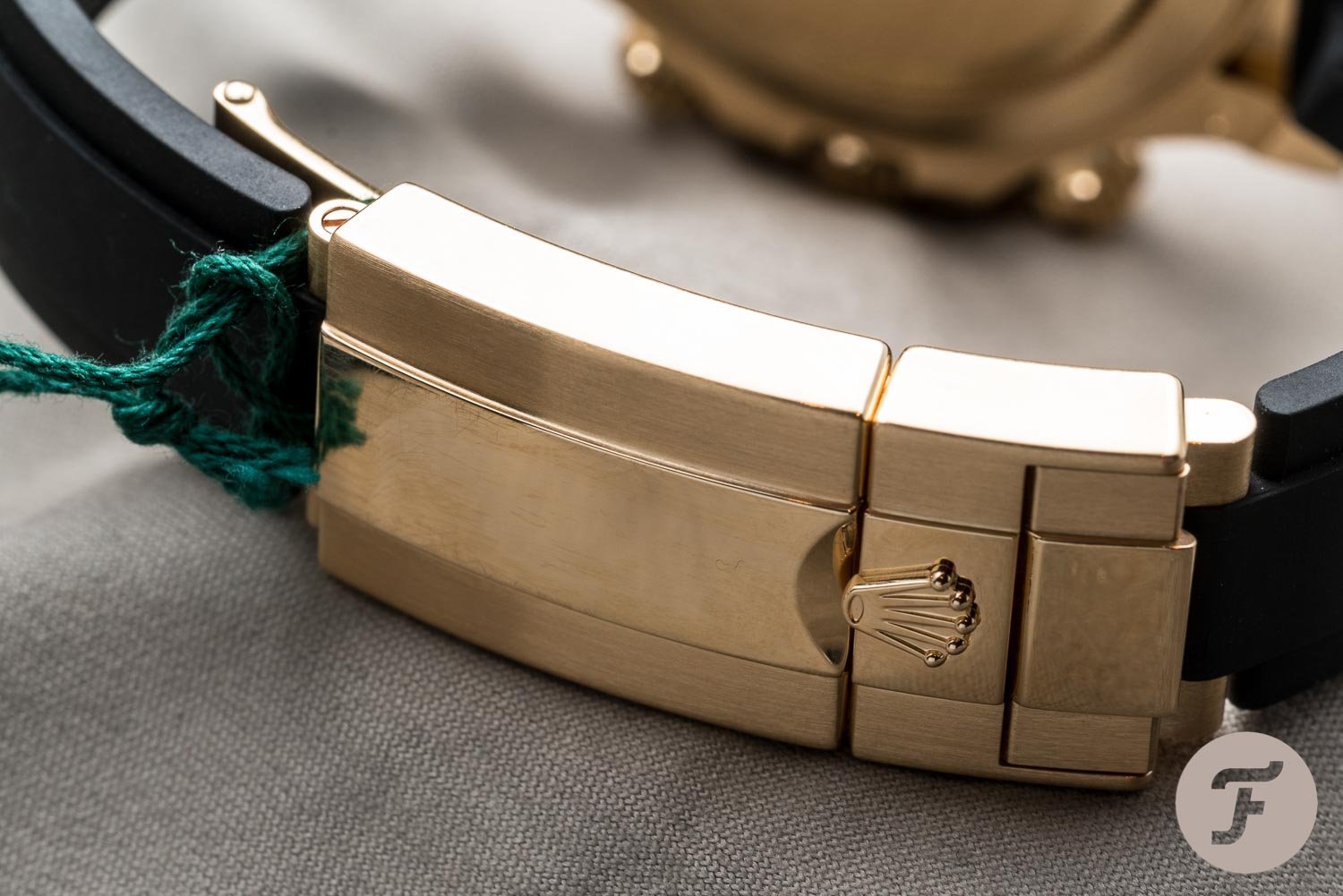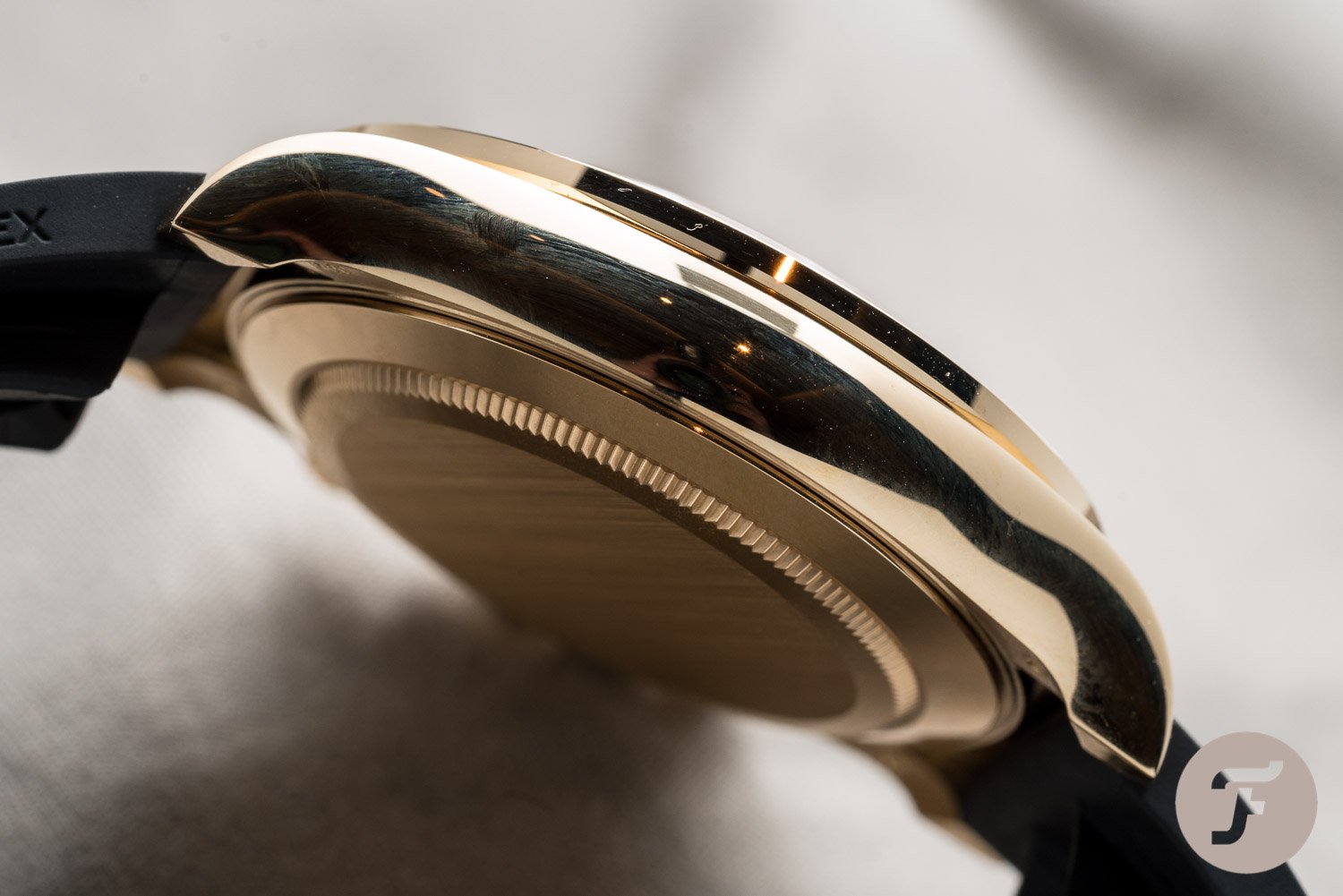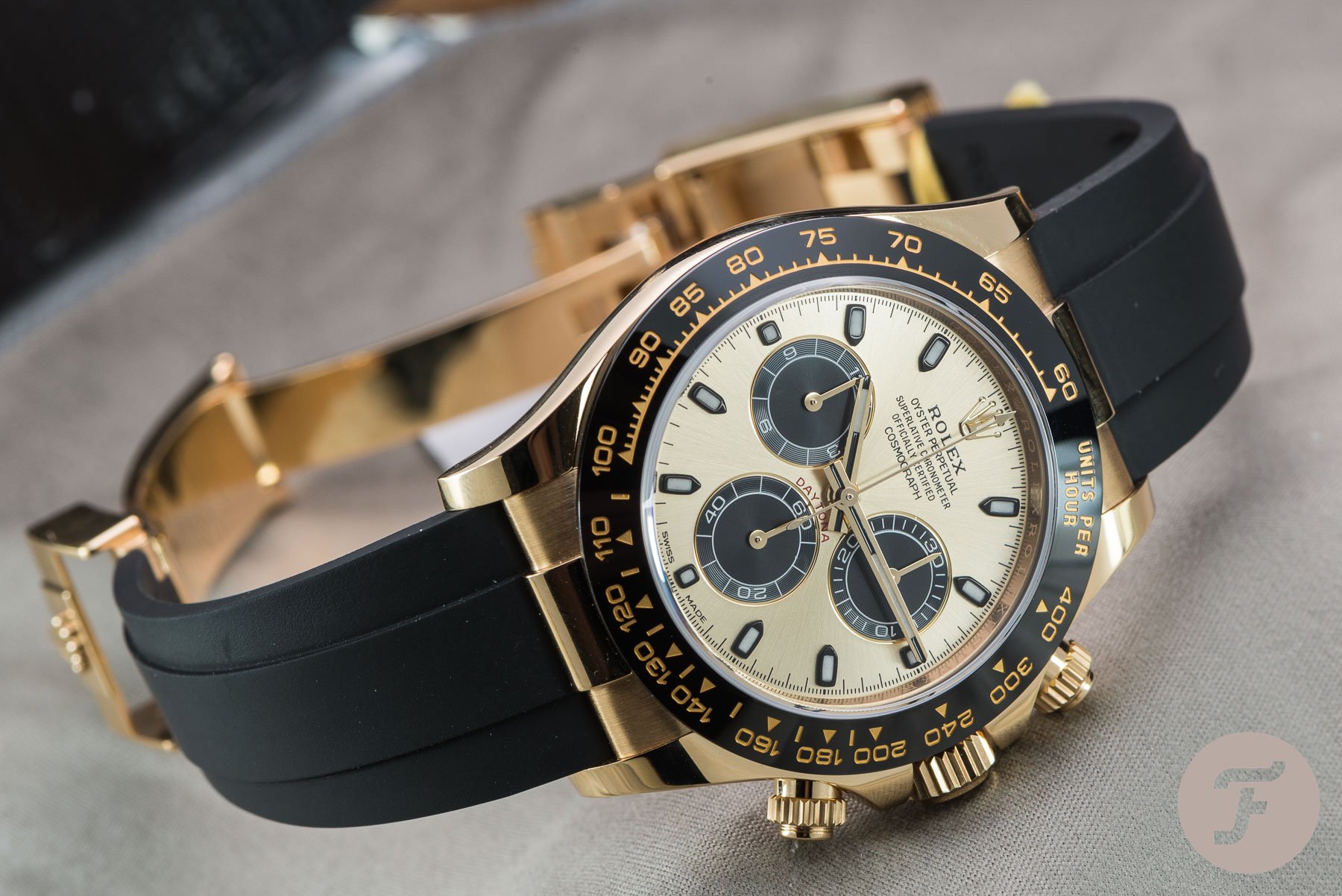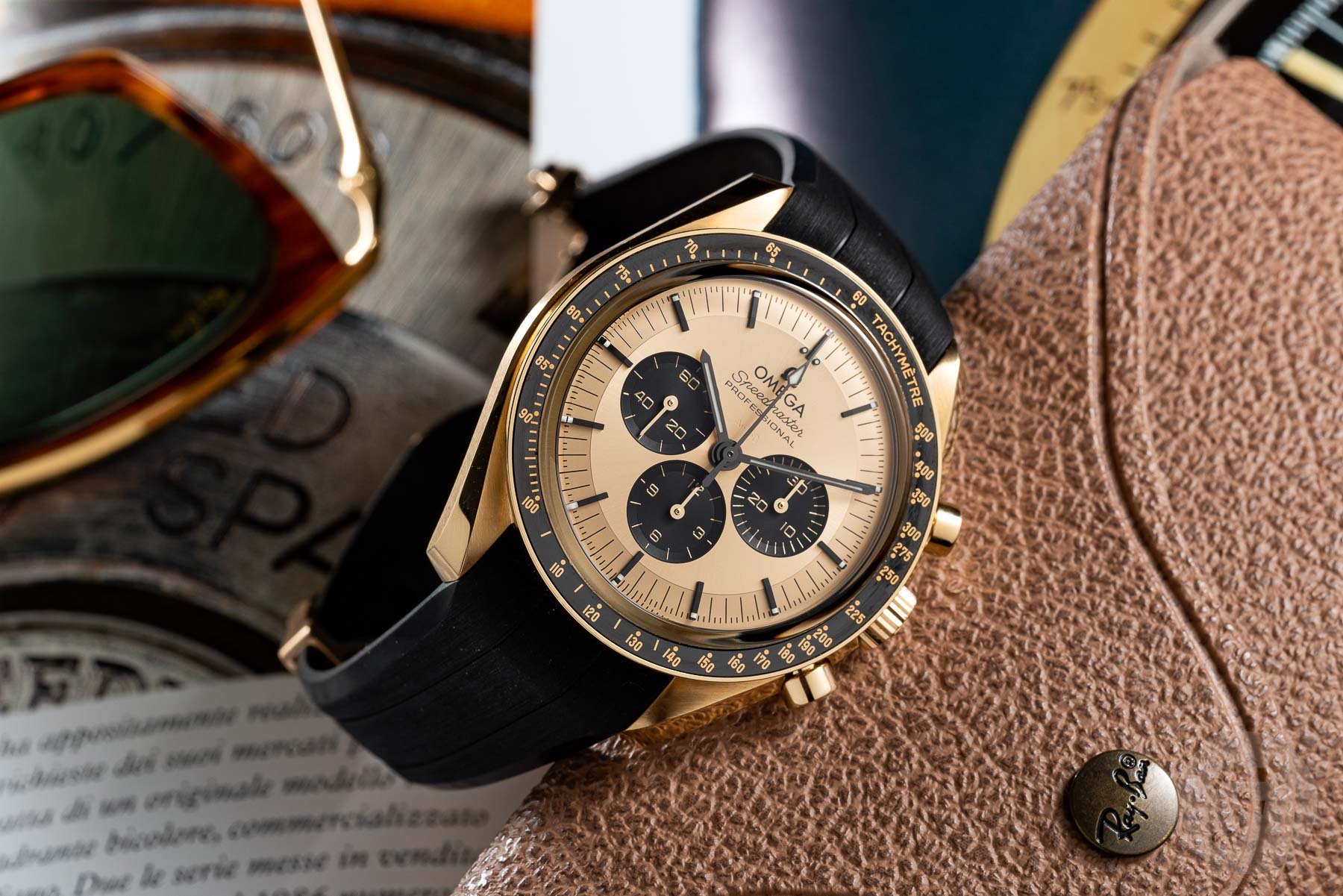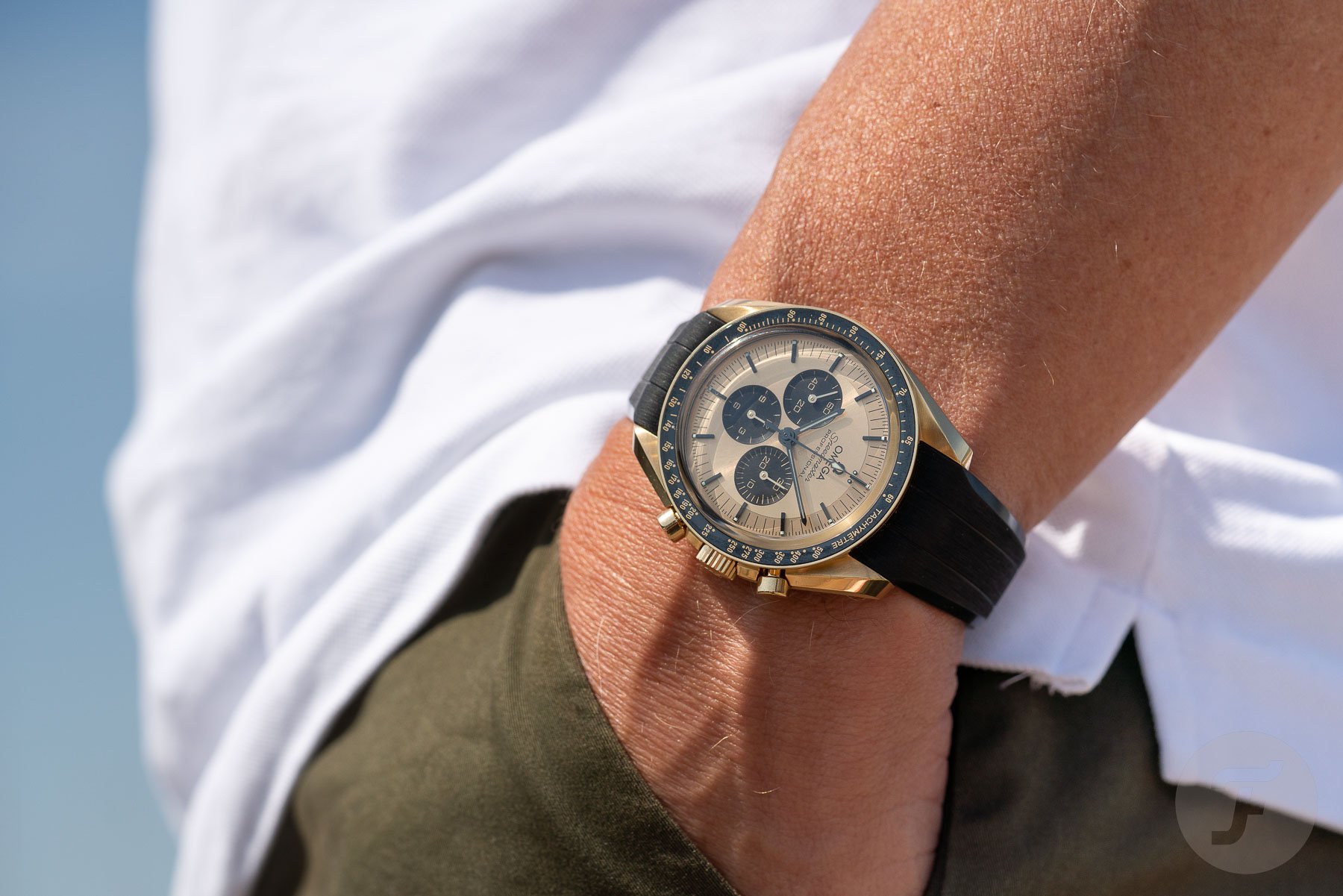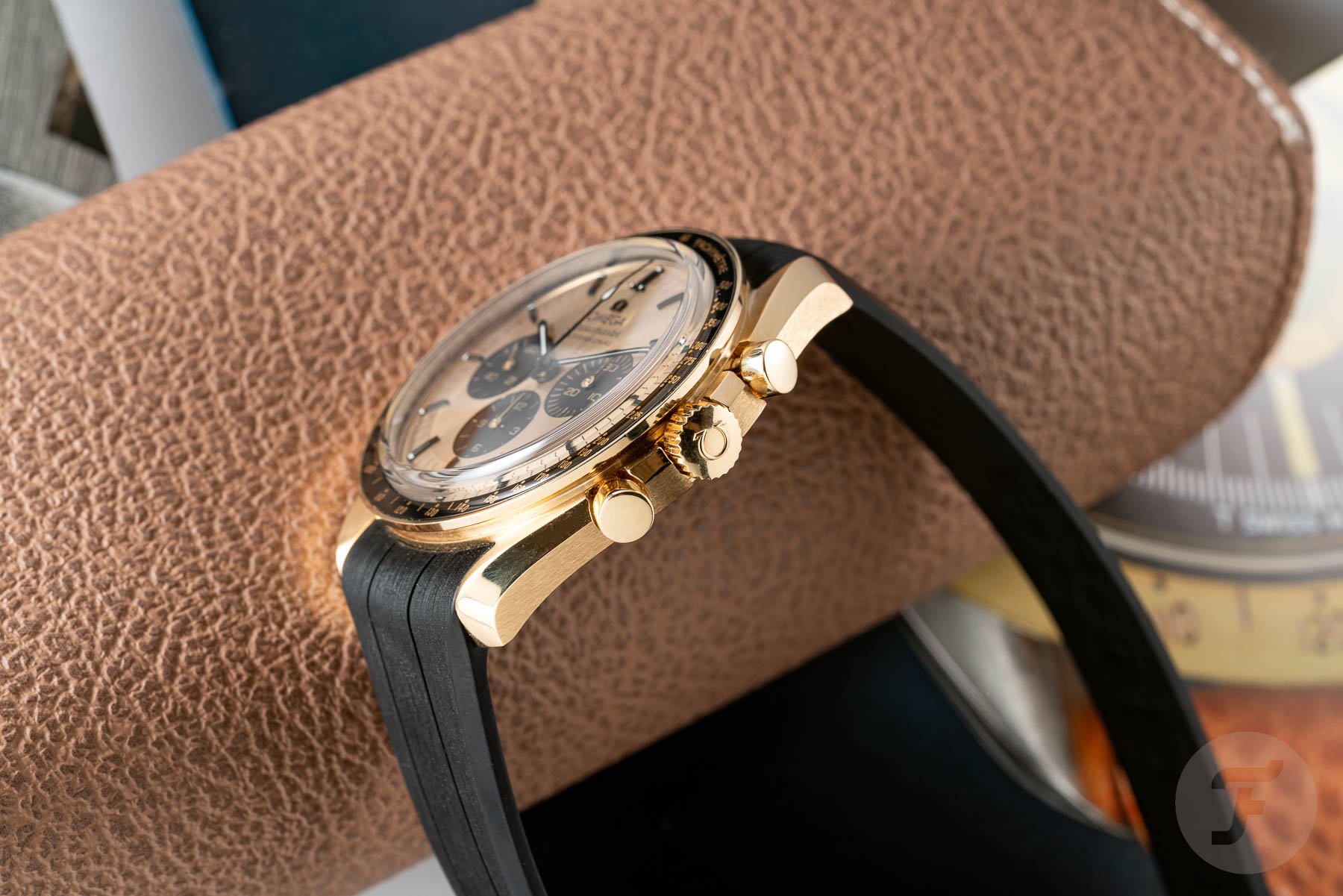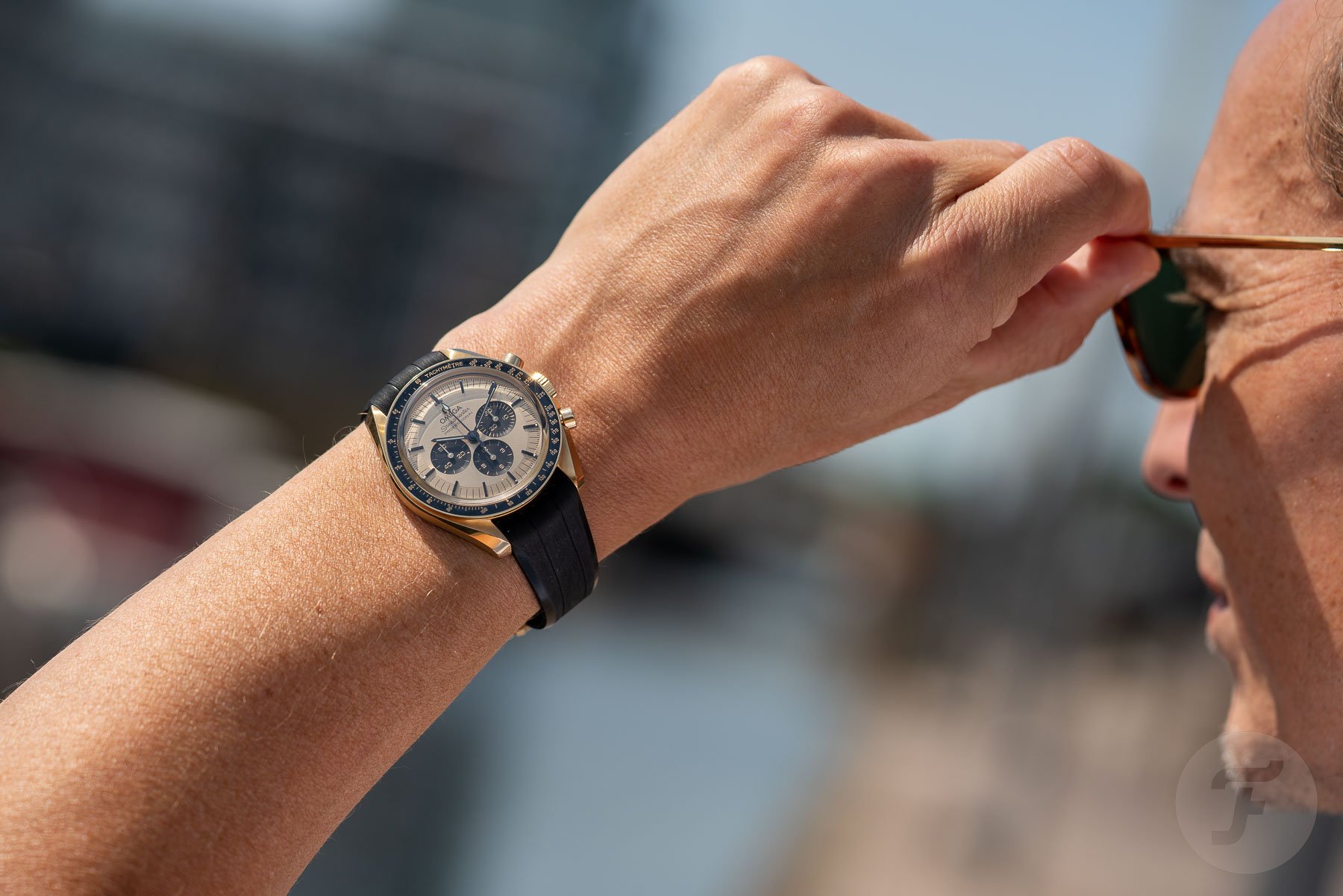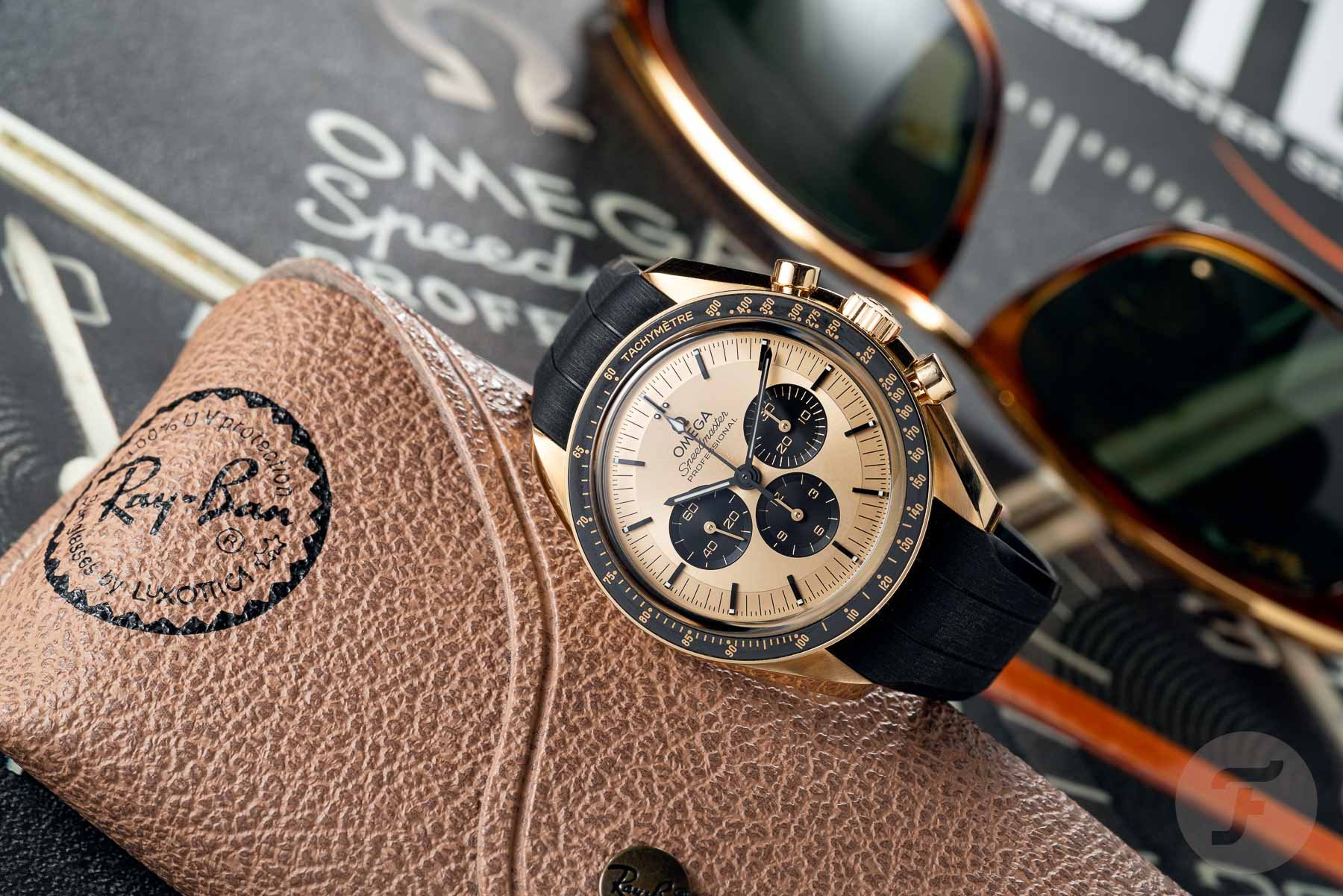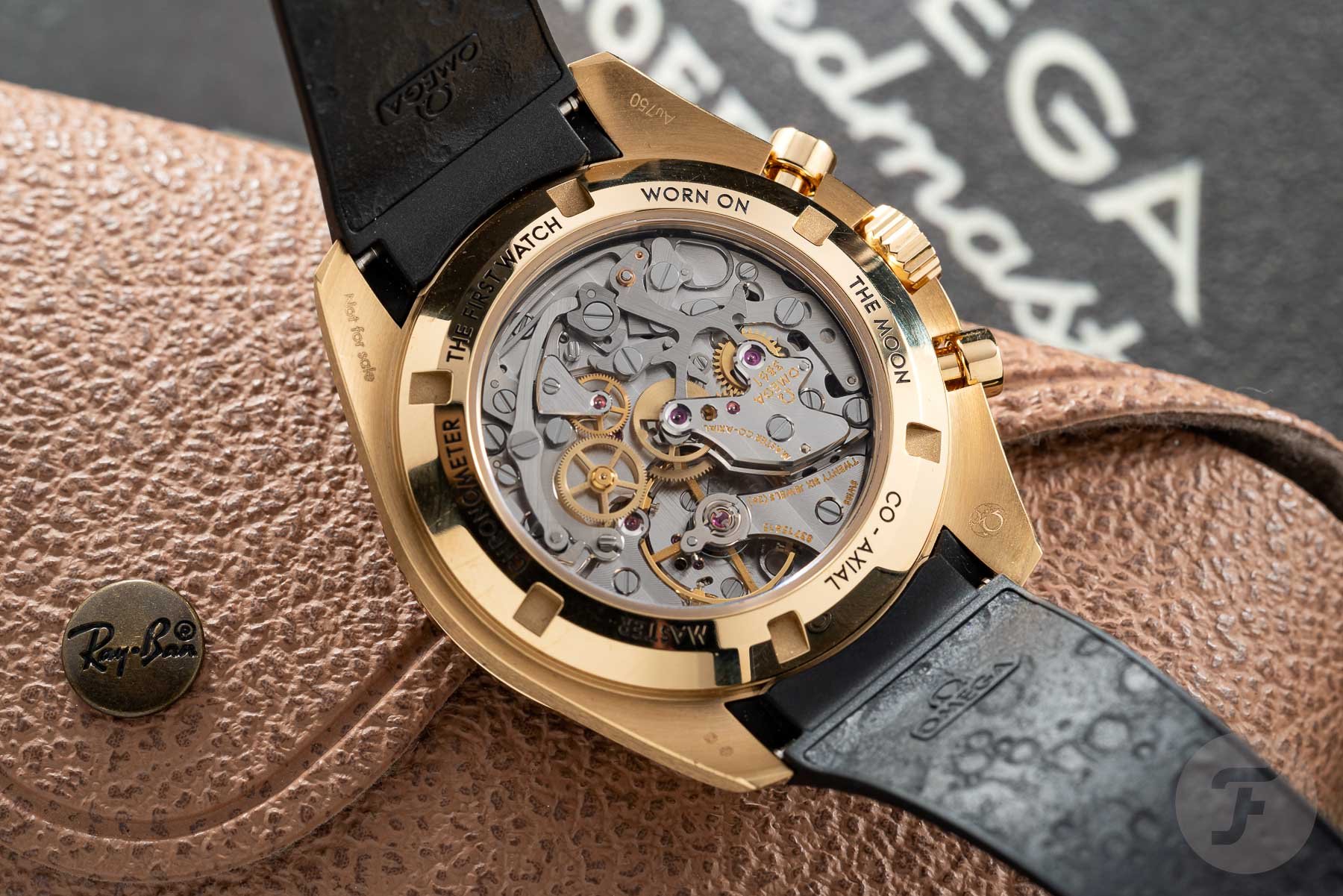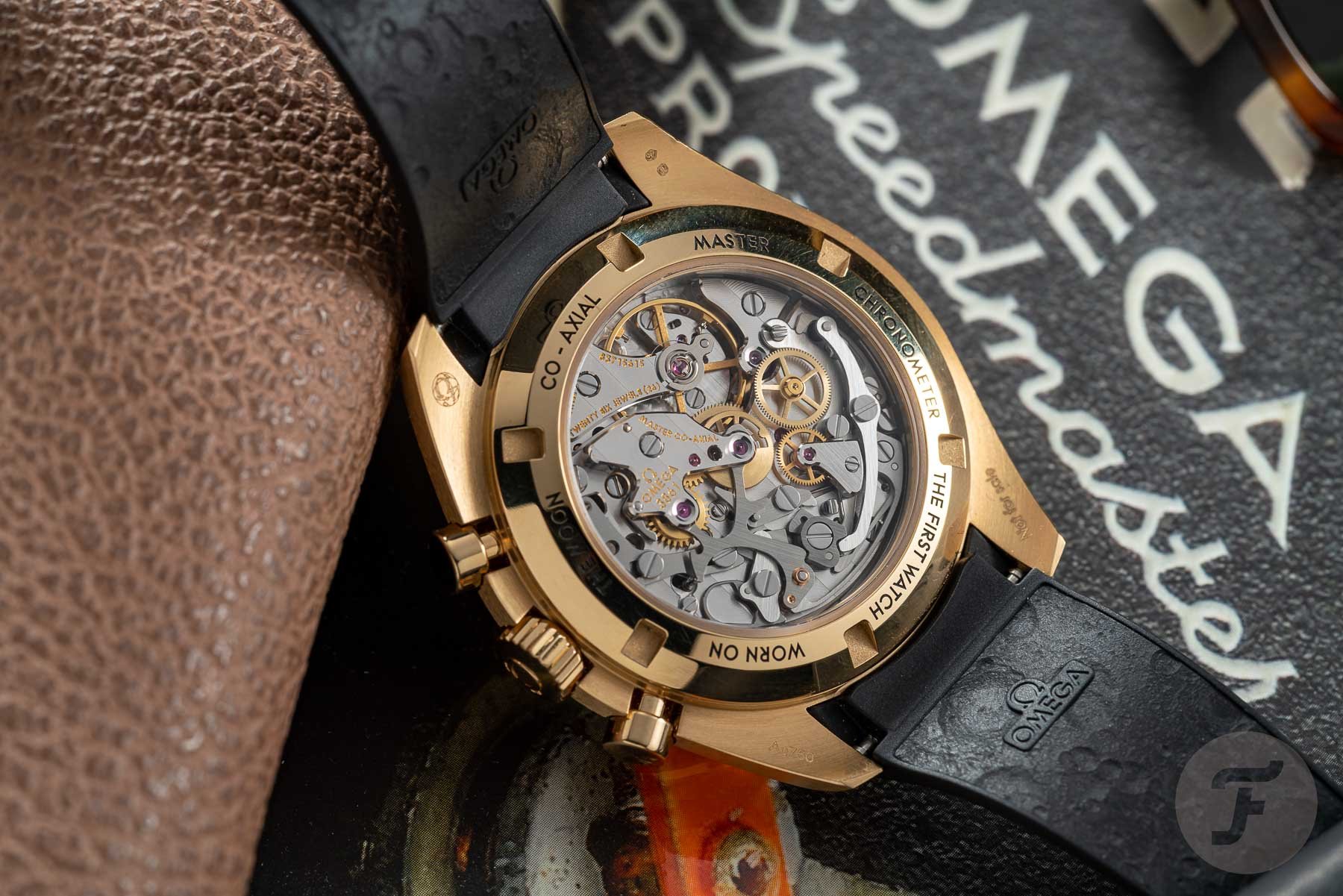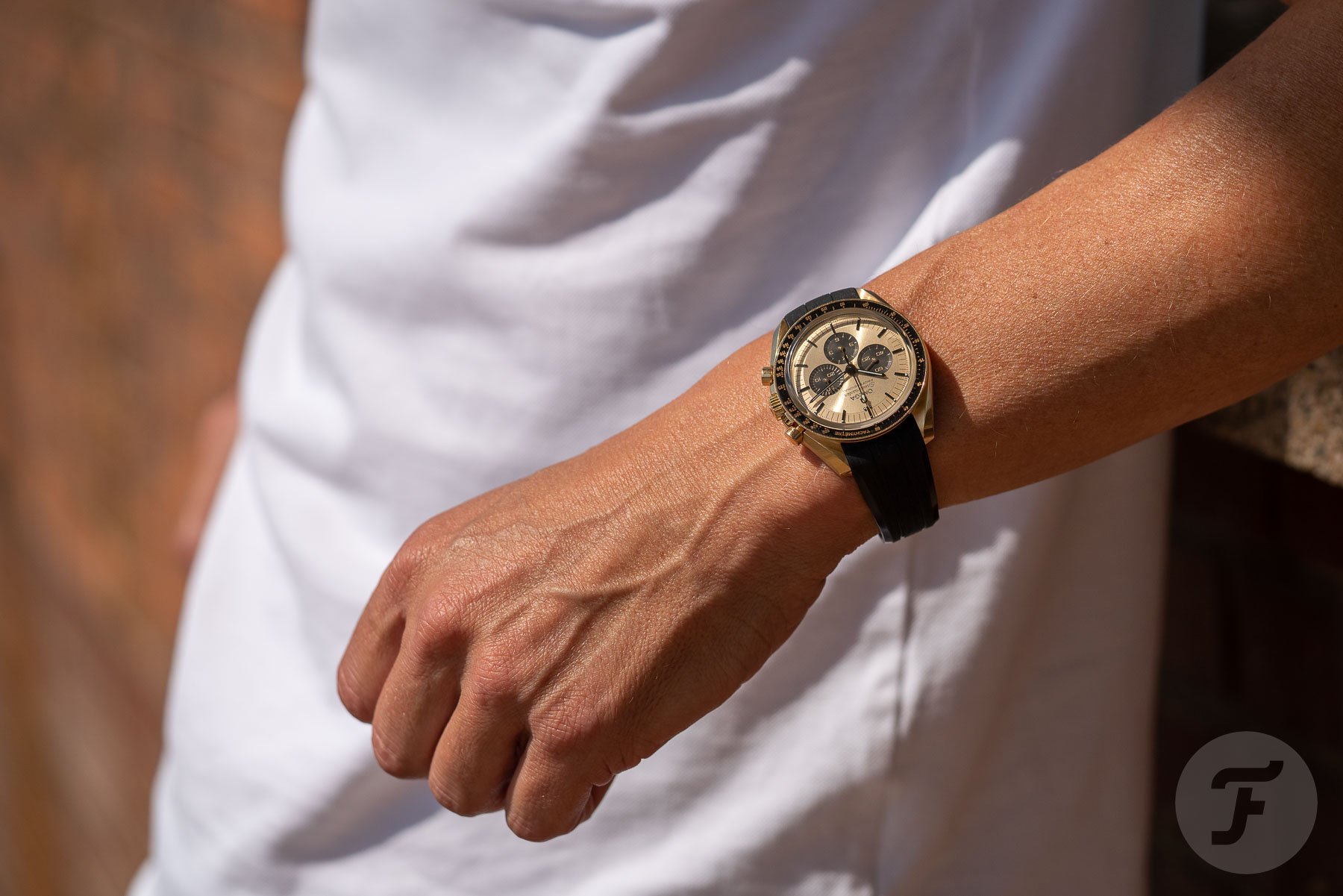Sunday Morning Showdown: Gold Chronographs Part Deux — Rolex Daytona Vs. Omega Speedmaster Moonshine Gold
Welcome to today’s edition of Sunday Morning Showdown! Like Hollywood movies these days, we’re running dry on new ideas. Hence, today is another sequel to a previous showdown. But that’s where you, dear readers, come in to suggest future topics. Whether it’s a single, polarizing watch for us to debate or whether two, four, or more watches face off in the arena, let us know your suggestions, and we’ll try to feature them in future editions. Despite today being a sequel, it’s still a corker. And in some ways, it’s an effort to amend a past battle that saw an unfair advantage. Today is “Gold Chronographs Part Deux” with the panda-dial Omega Speedmaster Moonwatch in Moonshine gold versus the Rolex Cosmograph Daytona in yellow gold. Let’s get to it!
In the original Gold Chronographs showdown between Rolex and Omega, we featured an Oysterflex Daytona versus a full-gold Speedmaster. As the comments rightly pointed out, there was a disparity in comparing the two models:
“Not sure why the Daytona was put in this fight on an Oysterflex, rendering it uneven because of the huge price and style difference.” — MARTIN
“I think a more appropriate comparison would have been to use the Rolex 116505 (full bracelet model), not the 116515 Oysterflex models.” — AS
So, today, we are righting the wrongs by bringing in a fully gold Daytona versus the new rubber-strap Speedy — just kidding, but I had you for a second. We’re in a bit of luck as Omega gave us the Moonshine gold Speedmaster with a rubber strap and gold folding buckle just this year. On top of this, both watches now share a golden panda dial and a black ceramic bezel.
Black Bay S&G versus Aquis Bicolor
With such a serendipitous launch to match the defiant Daytona, we have a fair fight on our hands. This should be a close contest design-wise and going by the specs sheet. Similarly, last week was a tight fight between the new bicolor Oris Aquis Calibre 400 and the Tudor Black Bay S&G.
While the price of the Tudor is very appetizing and the watch could be a better all-rounder than the Aquis, the new “Bicolor Blue” beats the Shield with 55% of the share. So with the score settled from last week, it’s time to see how today’s combatants fare. Ben backs the Rolex Cosmograph Daytona 116518LN with Jorg repping the Omega Speedmaster Moonshine 310.62.42.50.99.001.
Ben: Rolex Cosmograph Daytona 116518LN
Rolex habitually gives enthusiasts what they want, but with an expensive twist. Take, for example, the Rolex GMT-Master II in 2014. The bleu/rouge “Pepsi” aluminum bezel was quietly discontinued to make way for a future Cerachrom variant. The announcement was hotly anticipated, but when it finally arrived, the case and bracelet were rendered in precious white gold. The heavy-metal treatment was likely to limit demand, but the fans were a little let down. It was for a good reason, though, as Rolex was still developing its Cerachrom blue-and-red bezel and facing challenges in manufacturing. The bezel had to be in one piece to meet Rolex specifications, requiring an overlay of the blue and red colors.
This was no problem on the earlier bleu/noir “Batman” model as the black coloring superseded any blue underneath. But since Rolex’s red and blue hues don’t provide as much contrast, flakes in each color are placed on either side and baked at different temperatures on each half. The result leads to a bit of red on the blue side and vice versa, producing a purple hue when seen up close or compared to the old vibrant and distinct aluminum bezels. Rolex overcame the disadvantage via continuous improvement, and now Cerachrom colors have a stronger contrast. Although not quite the same as the aluminum bezels, the Pepsi eventually saw a release in Oystersteel in 2018, with the Oyster bracelet returning in 2021. However, when it comes to the panda-dial Daytona, you still have to pay a premium for the privilege.
The golden panda
Some could argue the current Oystersteel Daytona reference 116500LN is essentially a panda dial, but I am not convinced. The term “panda dial” refers to black sub-dials on a white or silver dial resembling a panda’s face. Likewise, a reverse-panda dial is white sub-dials on a black dial. The black sub-dial rings on the 116500LN are a subtle nod to the earlier reference 16520, otherwise known as the Zenith El Primero-powered Daytona. But the resemblance to the original “Exotic” dial references 6239 to 6265 is far removed. The panda and reverse-panda dials of the early Rolex Daytonas are one of the collection’s distinguishing characteristics. Yet, to replicate this look in a modern Daytona, you have to fork out the cash for a precious-metal variant.
It’s unusual, then, that Rolex solely reserves this classic and historical appearance for the gold pieces. When the Paul Newman reference 6239 that hammered for $15.5 million in 2017 is still one of the most expensive wristwatches ever sold at auction, you’d think that Rolex would capitalize on this for a more attainable steel example. Nevertheless, gold is the only avenue in yellow, white, and Everose forms. Technically, the watch I am representing today is a “golden panda”, thanks to the champagne sheen. The dial is not solid gold, but a brass plate galvanized and treated to appear gold. The sunray brushing is an additional motif that accentuates the opulence elevating the model above its steel counterpart. Offsetting the radiance are the solid black inlaid sub-dials with concentric grooves.
The Oysterflex
It may not have the practicality of steel or even an exotic red minute ring, but this 18K yellow gold Daytona is still a gem. The black gold indices with Chromalight offer an even more legible layout than the steel models. Adding to this is the Cerachrom bezel with yellow gold deposits within the engravings to keep the golden theme going. But above all, the combination with the Oysterflex bracelet gets me going. Rolex refers to Oysterflex as a bracelet rather than a rubber strap. This is due to the titanium/nickel alloy inserts that help keep the shape. It’s similar to the Audemars Piguet Royal Oak Offshore models that have precious gold bezels covered in rubber. However, for Oysterflex, there is a tangible benefit to its construction. The alloy inserts maintain the shape of the surrounding elastomer to prevent it from cracking at the pivot points.
This disintegration can be seen in rubber-strap watches worn consistently over many years. In my experience, my IWC Aquatimer’s rubber strap succumbed to cracking and discoloration. But this is not something you can expect from an Oysterflex bracelet. It does mean, however, that the Oysterflex cannot be cut to size. The clasp has adjustable holes to set the length without permanently damaging the bracelet. Inadvertently, the striking contrast between the black Oysterflex and the yellow gold material brings the dial forward and highlights the silhouette of the case. Isn’t black and gold a combination that you’re a fan of, Jorg? Well, Rolex has been doing this configuration since 2017. Perhaps the Hublot Classic Fusion and Offshore predate it with these juxtaposing materials. But only this year has Omega invited the Speedmaster to the gold-and-rubber party. The 2022 Omega Speedmaster Moonshine is the first to receive an integrated rubber strap with a matching gold folding clasp.
Going vegan
While it’s an excellent execution, the Daytona fits the lifestyle of a rubber strap (sorry, Oysterflex bracelet) better than a Speedmaster. Lex may believe the golden panda Speedy is the perfect summer watch, but I feel more comfortable with the additional 50 meters of water resistance in the Daytona for life aquatic. The Oysterflex model also brings on the vegan aspect. With this model release and the later addition of the Sky-Dweller with Oysterflex, the only leather-strapped Rolex model left is the Cellini Moonphase. Previously, a leather strap was a standard option on precious metal Daytonas.
I also prefer the half end link on this yellow gold model that fills the space where the strap end articulates. When the Oysterflex came to the market in the 2015 Yacht-Master, the flat ends of the strap did not sit flush with the curved case. This is still the situation on the Yacht-Master 42 in yellow and white gold, but the Sky-Dweller and Daytona Oysterflex watches get the half end link. Another feature of this yellow gold Daytona is the symmetrical crown guards. On the steel Daytona, the case is asymmetric with slimmer lugs on the crown side. The lugs on the precious-metal Daytonas are equal and flow into the pusher and crown guards. For me, it’s just a perfect package that shines all summer long for €27,700.
Jorg: Omega Speedmaster Professional Moonwatch Moonshine golden panda 310.62.42.50.99.001
Here we are again, Ben. We’ve seen this match-up between the Rolex Daytona and the Omega Speedmaster. As much as I adore Rolex and quite a few of its models from the Submariner to the Oyster Perpetual, the Daytona is different. I’ve said this before, but the hype of the modern-day Daytona escapes me. It’s not that I’m trying to be counter-cultural, as I find the history of the Daytona fascinating, especially with the hand-winding era. It’s just that the modern interpretation loses my interest.
In its first guise, the Rolex Daytona was a captivating chronograph, thanks in no small part to the reserved yet revered king of cool, Paul Newman. But with the introduction of the automatic Daytona in 1988, I felt the magic disappear. Now, when I look at this yellow gold 116518LN, I can see a generic luxury chronograph. For me, whatever lineage there was to the original Daytona is gone. It’s unusual as Rolex is typically the master of making iterative improvements on its icons without spoiling the heritage. With the Daytona, however, the Crown went a little buck wild.
Connecting the current Moonwatch with the past
Regarding historical connections, Omega has a better track record with the Speedmaster Professional Moonwatch. Although, for me, it was not love at first sight with the Moonshine golden panda. Omega introduced this variant earlier in the year along with the Moonshine gold green dial/bezel variant. I went hands-on with the green Moonshine here, which I enjoyed on the green alligator leather strap. Yet, seeing a Moonwatch on a rubber strap took some getting used to. This is the first time that Omega has released a Speedmaster Professional Moonwatch on a rubber strap. Omega also offers the golden panda on the 1479-style gold bracelet with a PUSH extension clasp, which would be my pick.
But despite the gold-and-rubber combo seeming a bit weird at first, it was a different story on my wrist. I previously had the pleasure of reviewing the Omega Seamaster Professional 300M Chronograph in Sedna gold. The rubber strap’s comfort makes that big Seamaster seem entirely wearable and properly supports the weighty gold case. But the Sedna gold Seamaster chronograph is a dive watch, so would the gold-and-rubber concept transpose to the iconic Speedmaster? I am drawn to the mix of rubber and gold. As you said, Ben, the original Hublot by the visionary Carlo Crocco first combined these materials. There is something very provocative about the clash of styles, or as Jean-Claude Biver would say, “the Art of Fusion.”
Translating the past to the future
While many Speedmaster models have changed the formula entirely, the Moonwatch is sacred territory. That’s perhaps why it has taken so long to get the rubber treatment. Besides the strap, the Moonshine golden panda has the trusted 42mm asymmetrical case. Unlike the Daytona’s gold PVD dial, Omega renders the step dial in solid gold with a sunburst finish. It creates a far more mesmerizing style than the Daytona’s brass effort. The contrast is also striking with the black sub-dials and black Ceragold ceramic bezel.
Omega uses black PVD hands and markers to stand against the gold background. Conversely, the Daytona has yellow gold hands that blend in against the matching dial — not what you want for a legible chronograph. Overall, the Moonshine golden panda’s mixture of colors and textures is far more pleasing to the eye. Including the rubber strap, the shifting surfaces create a contrasting yet harmonious aesthetic. The matte black rubber strap tapers from 20mm at the case to 16mm at the matching Moonshine folding clasp. To embrace the story of the Moonwatch, Omega subtly embosses a lunar-surface texture on the inside of the strap. While it’s business on the outer surface of the strap, a party is happening on the underside.
The Moonwatch is a storyteller at heart
The story continues when you turn the watch around with caliber 3861 visible through the sapphire case back. With the rhodium-plating, this is the same movement that powers all the current Moonwatch models except for the Apollo XI and Snoopy variants, which have slightly different finishing or an automaton. The 26-jewel manual-wind movement operates at 21,600vph with a power reserve of 50 hours. Being a Master Chronometer, it is also equipped with the Co-Axial escapement with an average deviation between +0 to +5 seconds per day. METAS also officially certifies each caliber on top of COSC and ensures they can withstand magnetic fields of 15,000 gauss. Caliber 3861 also finally incorporates hacking seconds for accurate time setting.
This is why the Moonshine golden panda takes the win for me, Ben. Besides the evolution of a historic caliber and higher concentration of gold, the Moonshine Moonwatch has a better story. Also, based solely on appearance, the Moonwatch wins hands-down. Strapping the Moonshine Moonwatch on the wrist with that reassuring click of the gold deployant makes all the difference. That’s where it shows its true brilliance, just as Lex explained in his love letter. That’s why in the imaginary bank of Jorg, there’s a fictitious balance of €30,400 waiting to purchase this piece.
It’s up to you now
Whose side are you on? Would you pick Jorg’s Omega Speedmaster Professional Moonshine golden panda? Or would you go for Ben’s Rolex Cosmograph Daytona in yellow gold? Both are grand luxury statements with a sporty twist. But which will come out on top? Let’s bring this one to a close and let the readers cast their vote. Feel free to voice your choices in the comments of whose side you’re on and why.

